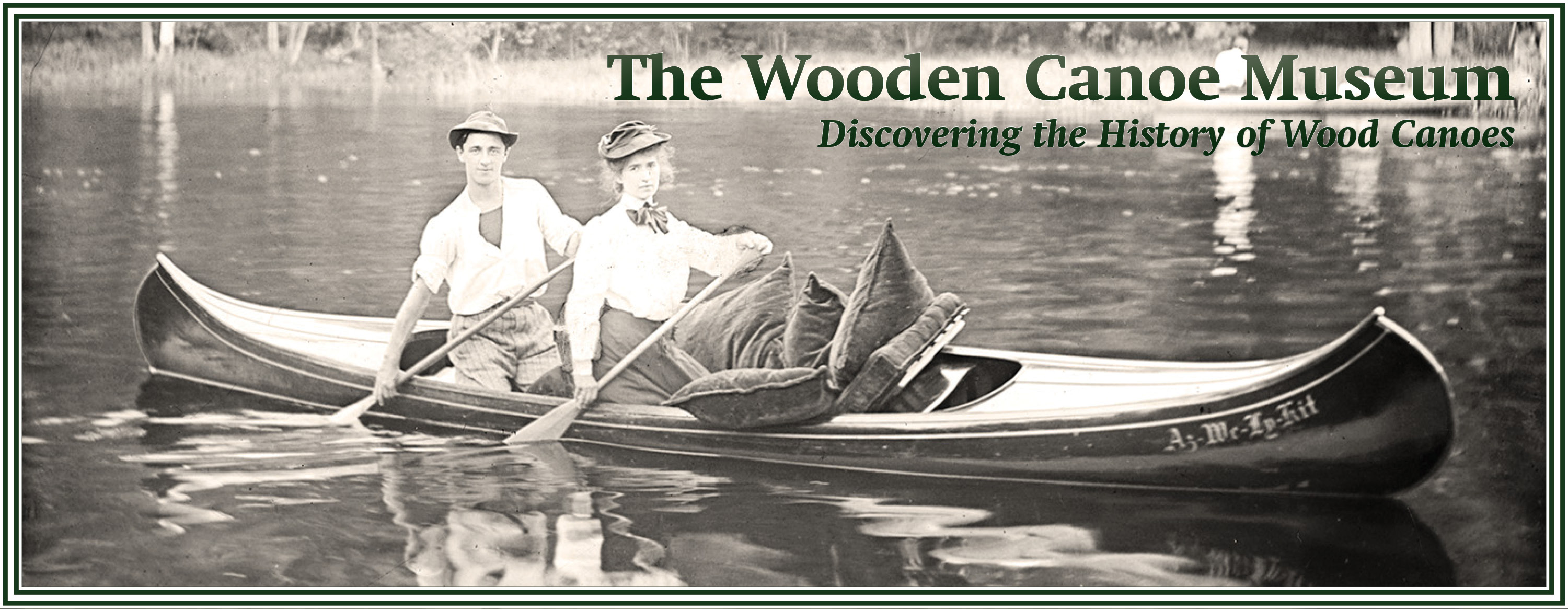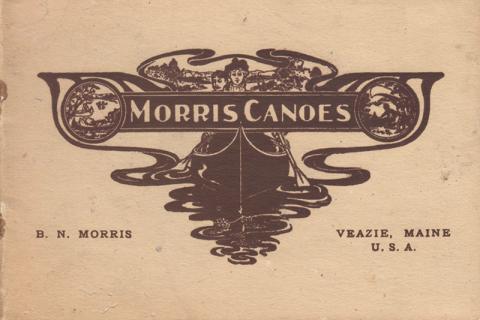The B.N. Morris Company of Veazie, Maine, was in business for approximately thirty-years. Charles and Bert Morris began building canoes in the barn attached to the family home and a separate shop behind this building and began selling them commercially from 1891. Eventually, the B.N. Morris Company maintained a factory with many buildings, selling their “first quality” B.N. Morris canoes through dealerships in many countries and a less-expensive Veazie Canoe Company canoe factory-direct.
It isn’t known what became of the B.N. Morris Company records. They may have been lost in the fire or were destroyed at a later time, or they may eventually turn up. Although it isn’t possible to tie a Morris serial number to original build information, details ascertained from existing Morris canoes have produced a theory permitting us to suggest a build-date.
A fire, described in the Bangor Daily News as “… very spectacular, lighting up the country for miles around”, destroyed the B.N. Morris factory in Veazie, Maine, the evening of Monday, December 15, 1919. Articles from the Bangor Daily News and the Bangor Daily Commercial contain interesting accounts of the fire. The articles contradict each other in regard to the possible location of the fire’s start and the extent of loss. Both articles assure the public that the factory would be rebuilt, but it was not.
There are only three known Morris canoes with a metal name plate, and they are considered to date from the early 1890s. It would seem Morris replaced use of the metal plate with a decal, possibly as a cost-saving measure. In general, the decal came into use in the United States in the mid-1890s, and Morris may have begun using the first of his decal-types at this time.
Three decal-versions are found on Morris short decks:
Version #1 is found on three canoes, which appear never to have had a serial number.
B.N. Morris
Canvas Canoes Row Boats
and Equipments
Veazie, Maine
Version #2 is found on canoes which appear never to have had a serial number, through canoes with serial numbers up to 10XXX.
B.N. Morris
Builder
Canvas, Paddling & Rowing
Canoes
Veazie, Maine
Version #3 is found on canoes with serial numbers above 10XXX.
B.N. Morris
Builder
Canvas, Paddling & Motor
Canoes
Veazie, Maine
A simple version is found on the coaming of long-decked canoes and on some Morris accessories:
B.N. Morris/Builder/Veazie, Maine
Morris decals with the word "rowing" came into being before the Morris Company was building any canoes with motors. In approximately 1910, Morris was producing a motor canoe and the decal was changed to reflect this. Since far fewer canoes were rowed than were paddled, it probably seemed more reasonable to eliminate "rowing" and substitute "motor".
We can't say with absolute certainty that no "rowing" decals were used after the "motor" ones arrived, so a canoe from this "transition period" of around 1912 could have either decal. What we do know is that Morris 10090 has a heart-shaped deck with a decal that has the "motor" wording, and this is the lowest serial number with a "motor" decal. This canoe is circa 1912-13, according to current theory.
It seems Morris began assigning serial numbers around 1900. We have a receipt showing Morris #1876 was shipped June 1, 1903. The following table permits the attachment of a possible shipping-date to a specific serial number. Use of “circa” works well, as it means “around the time of”; for instance, my 15XXX Morris was built c.1918. Many thanks to Mike Cyr for working on this table.
| Year | Serial Number | Year | Serial Number |
| 1900 | 1-469 | 1910 | 6754-7629 |
| 1901 | 470-985 | 1911 | 7630-8567 |
| 1902 | 986-1556 | 1912 | 8568-9543 |
| 1903 | 1557-2182 | 1913 | 9544-10694 |
| 1904 | 2183-2873 | 1914 | 10695-12045 |
| 1905 | 2874-3574 | 1915 | 12046-13546 |
| 1906 | 3575-4325 | 1916 | 13547-14897 |
| 1907 | 4326-5101 | 1917 | 14898-15798 |
| 1908 | 5102-5902 | 1918 | 15799-16499 |
| 1909 | 5903-6753 | 1919 | 16500-17263 |
- Special Indian: Prior to approximately 1905, this was the name of one of the two Morris models.
- Special Indian, Extra Beam: Prior to approximately 1905, this was the name of the wider of Morris's canoe models. Its catalog image is used as the WCHA logo canoe.
- Model A: "Model A, is for all-round use, and will be found efficient, safe, staunch and comfortable, principally due to the flat floor, full rounded sides, and remarkable surface bearing. Its dimensions are moderate and pleasing in lines, and from its first appearance on the market up to this day, all users have only the highest appreciation. This model is built with two styles of ends; the Special, or so-called Torpedo ends, and the Standard Ends.” (1919 Catalog)
- Model B: “Model B, which is a later development, has been very much appreciated by those who desire a canoe with greater capacity, for family use. It has been on the market a number of years, with a steady increase in demand. Its lines in general are very pleasing, and its paddling qualities are exceptional, considering its dimensions. It is also a very fine canoe to equip for rowing.” (1919 Catalog)
- Model C: “Model C, carries about the same dimensions as Model A, except that it has less tumble-home and sharper lines for and aft. It is a fairly speedy canoe.” (1919 Catalog)
- Model D: “Model D is a design with more freeboard and less tumble-home. Has quite a flat bottom, and is quite seaworthy. its paddling qualities in quick water are excellent, and it is unequalled as an open sailing canoe. Its principal uses are hunting and cruising.” (1919 Catalog)
- Tuscarora: "A model designed specially for racing, and is without a doubt a fast canoe. It is built in two lengths, 17 and 18 feet. To obtain lightness it is fitted with light, tough spruce wales, seats, braces and decks. it is also furnished without keel or floor rack, unless ordered (no charge). Other extras can be had to order at regular prices." (1919 Catalog)
- Molitor: 18 feet long, with 36 inch bow deck and 24 inch stern deck; canoe is usually tricked-out with rub-rails, extended (torpedo) stems, outside stems, D-shaped outwales, half ribs, floor rack, flag sockets, and is seen fitted with bilge keels and spotlights. This model wasn't offered in any known Morris catalog, but was a distinctive canoe built for C.J. Molitor's Livery on Belle Isle in Detroit. After the Morris factory fire, the model was built by Old Town. There is also a Carleton Molitor model. The Molitor name is currently attached to the most expensive of Old Town's canoe models.
| Morris Model Dimensions | ||||||
|---|---|---|---|---|---|---|
| Length (ft) | Beam Extreme (in) | Depth (in) | Length (ft) | Beam Extreme (in) | Depth (in) | |
| Model A | Model C | |||||
| 15 | 33 | 12 | 16 | 33 | 12½ | |
| 16 | 33½ | 12 | 17 | 33½ | 12½ | |
| 17 | 34 | 12 | 18 | 34 | 12½ | |
| 18 | 34½ | 12 | ||||
| 20 | 36½ | 12 | ||||
| Model B | Model D | |||||
| 12 | 35 | 13 | 17 | 35½ | 14½ | |
| 13 | 35 | 13 | 18 | 36 | 14½ | |
| 15 | 35½ | 13 | ||||
| 16 | 36 | 13 | Tuscarora | |||
| 17 | 37 | 13 | 17 | 31½ | 12 | |
| 18 | 37½ | 13 | 18 | 31½ | 11½ | |
B.N. Morris canoes were offered in a single grade, and are usually found with mahogany decks, thwarts and seat frames. Rails may be spruce or mahogany. If outwales are mahogany, they are D-shaped. Open gunwales are mahogany with a D-outwale. The following "Types" were offered:
- Type 1: Spruce gunwales, mahogany seat frames, braces (thwarts), short decks. Spruce grate (floorboard). Keel.
- Type 2: Spruce inwales, stained. Mahogany top and outwales. 24” mahogany decks, flag socket, painter ring, mahogany seat frames and braces, spruce grate, keel.
- Type 3: as with Type 2, with the addition of oak outside stems
- Dean, Jeff and Jill. 1985. Morris Potpourri. Wooden Canoe 21:3-6 (Winter 1985)
- Klos, Kathryn. 2007. Veazie: A Catalog Found, A History Unfolds. Wooden Canoe 144:12-15 (December 2007)
- Klos, Kathryn. 2008. B.N. Morris Research Update. Wooden Canoe 146:14 (April 2008)
- Klos, Kathryn. 2008. B.N. Morris Database Update: The Canoes Speak. Wooden Canoe 148:10-13 (August 2008)
- Klos, Kathryn. 2009. The Canoes of Belle Isle. Wooden Canoe 156:7-14 (December 2009)
- Klos, Kathryn. 2011. B.N. Morris Decals. Wooden Canoe 164:7 (April 2011)

